Uber Partners with Leading Architecture Firms to Reveal First uberAIR Skyport Designs
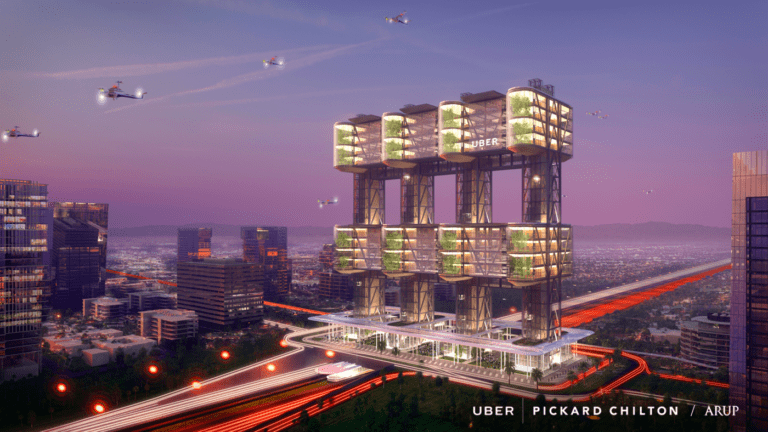
LOS ANGELES – At Uber’s 2nd Elevate Summit, six leading architecture and engineering firms showcased the first designs for uberAIR Skyports. These conceptual designs mark the first steps from industrial leaders to create infrastructure for high-volume operations of uberAIR networks in and around cities.
From dozens of submissions, six concepts were selected which demonstrate a high degree of realism and technical feasibility. Finalists include: Gannett Fleming, BOKA Powell, Humphreys & Partners Architects, Pickard Chilton working with Arup, Corgan, and The Beck Group.
The Skyports are designed to support uberAIR landing and take-off at a busy, high-volume location such as a stadium or concert hall. The concepts are required to support transport of more than 4,000 passengers per hour within a 3 acre footprint and must meet noise and environmental requirements, ensuring that 100% electric VTOLS are able to recharge between trips with minimal impact to nearby communities.
“Today Uber invited six of the most innovative architectural firms to share their concepts at our annual Summit. This is the culmination of hundreds of designers and engineers that have created dozens of designs for a highly efficient and modular Skyport. While uberAIR might feel like a far away dream, it’s closer than you think and urban infrastructure has to start to evolve now to keep up. We’re excited to have collaborated with leading firms to imagine how physical Skyports would work at scale and how we can best design spaces that are quiet, environmentally conscious and create natural pockets of activity for the transportation of the future,” said John Badalamenti, Uber’s Head of Design for Advanced Programs and Aviation.
You’ll find images and videos of all 6 final designs here and a summary below.
Uber Elevate Skyport Challenge – 6 Final Designs
Gannett Fleming — “The PAW”
Inspired by nature, Gannett Fleming’s concept includes paw-like landing platforms. The design would support 52 eVTOLs per hour, per module in a scalable framework that could facilitate more than 600 arrivals and departures and 4,000 people per hour by 2028.
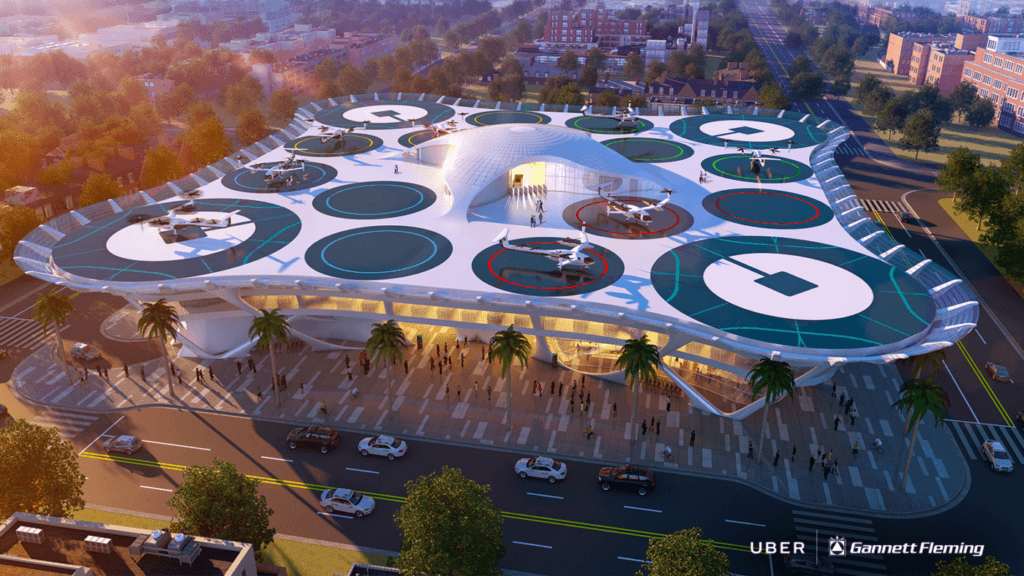
The design uses robots to rotate the eVTOL aircraft 180 degrees on their parking pads to position them to taxi for immediate takeoff. With sustainability in mind, the Skyport includes photovoltaic receptors and transparent concrete to enable solar recharging, and sound walls with acoustic baffles to let the wind pass through and minimize noise impacts.
“We have the opportunity to rewrite how our transportation systems work and to reshape our urban environments to be cleaner, safer, less congested, and smarter,” said Ted Osborne, PP, AIA, principal architect at Gannett Fleming. “Gannett Fleming’s goal is the same as Uber’s – to make transportation safe, accessible, reliable, and convenient for everyone. Our Skyport solution, The PAW, will integrate seamlessly as an intermodal transportation hub and an elegant solution supporting landing pads with a fluid and organic structure.”
Pickard Chilton and Arup — “Sky Tower”
Pickard Chilton and Arup’s design is driven by function, creating a form that would support, augment and perhaps ‘elevate’ the Uber brand. A single module allows for 180 landings and takeoffs per hour, accommodating 1,800 peak passengers every hour per module. Modules can be combined both vertically and horizontally to allow the Skyport to adapt to the city landscape.
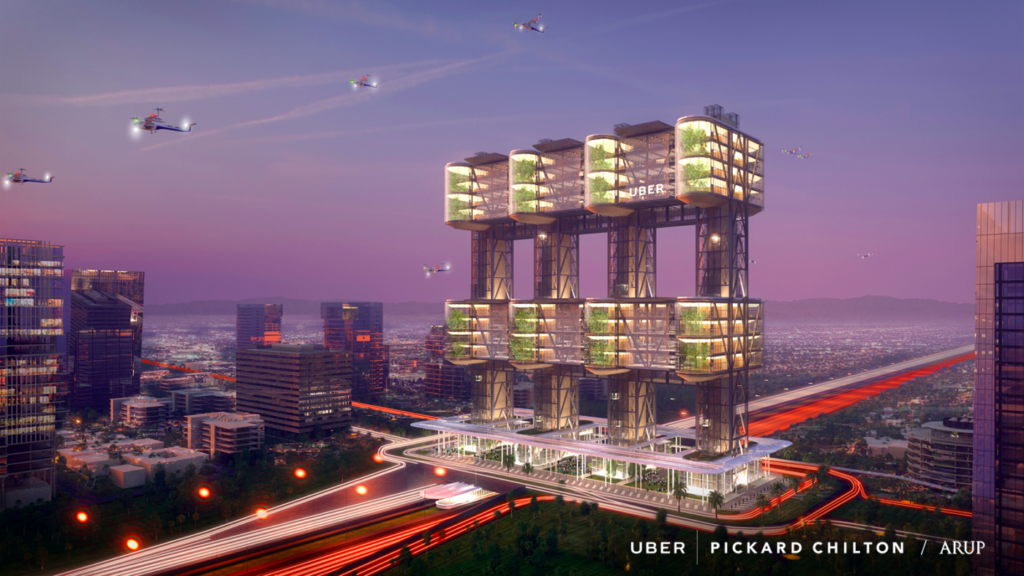
“The Pickard Chilton and Arup concept for the Uber Skyport presents a functional design that is respectful of its community, efficiently achieves Uber’s capacity objectives, and is an elegant yet highly engineered and sophisticated work of architecture,” said Jon Pickard, FAIA, RIBA, Principal at Pickard Chilton. “While our design for the Skyport is conceptual, it is not science fiction. Based on a pragmatic and research-driven approach, our concept delivers to Uber a modular, extensible and sustainable solution that supports their vision for the future of intra-urban transportation.”
Corgan — “CONNECT”
Corgan’s CONNECT is a futuristic and forward looking Mega Skyport concept designed to repair the way roads and highways have partitioned modern cities. The Skyport design can accommodate 1,000 landings per hour.
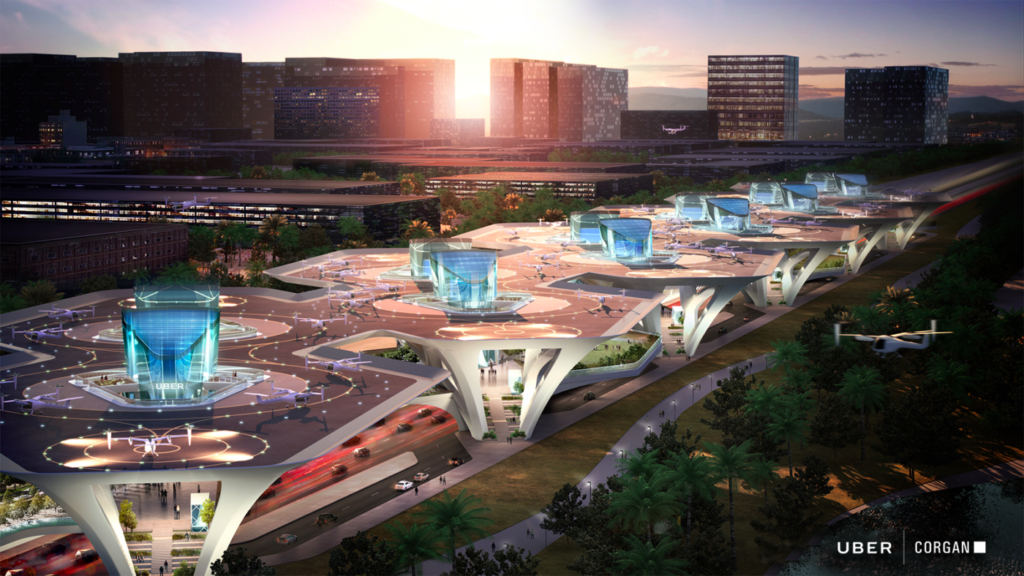
Corgan’s design coordinates with established highway networks to repurpose existing and familiar infrastructure and create new travel arteries that can accommodate the higher throughput required of mass adoption. By bridging the divides that highways have left in urban fabric, CONNECT seeks to reconnect communities and provide a commercial and social opportunity for neighborhoods while providing enhanced access to urban air transportation.
“As aviation architects, we focus on enhancing the passenger experience and making that experience accessible for everyone,” said John Trupiano, principal at Corgan’s Aviation Studio. “So, while the main task of the Uber Skyport is to develop a paradigm for public access to eVTOLs, we extended it to explore how Skyports could reconnect the community, how they can become an important amenity to the neighborhood, and how they could bridge some of the divides we see in our cities.”
Humphreys & Partners — “Uber Hover”
Humphreys & Partners Skyport concept is modeled after a prototypical beehive. Similar to bee’s flight patterns to and from a beehive, the aircraft replicate the same function by showcasing multiple ports of entry and operation.
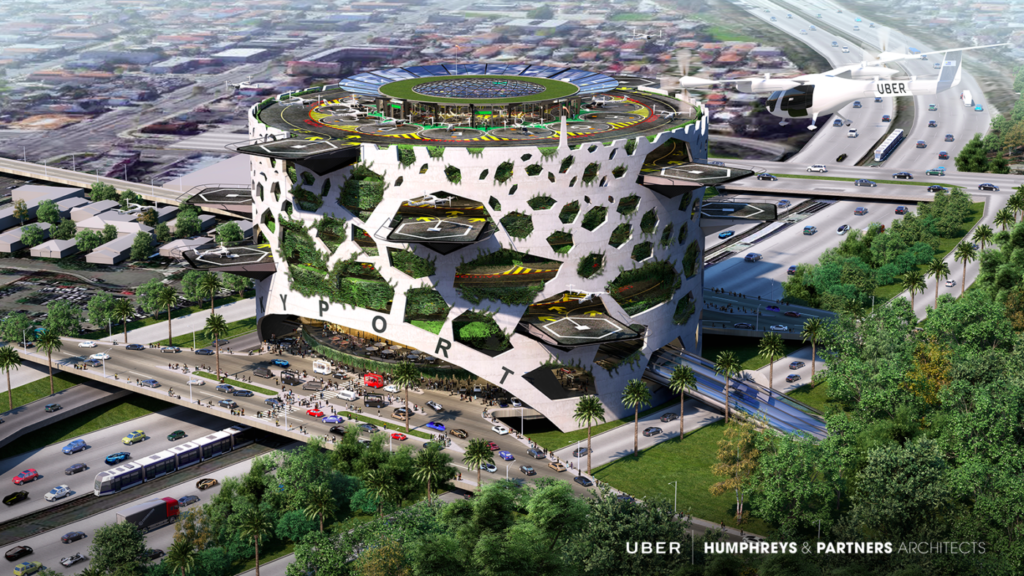
The design accommodates 900 passengers per level, per hour and uses sustainable materials to create an ecosystem that powers itself and gives back to the surround area.
“When designing the Skyport and Mega-Skyport, it was important to think about concepts that fit present-day technology and existing developments, but can also adapt with shifting trends,” said Walter Hughes, vice president of design. “Developers constantly ask us about the future of parking garages, as modern modes of transportation reduce the need for traditional parking. Uber Elevate offers a viable solution. We focused on a design that can easily be replicated and expanded. Add retail, office and more, and we’ve expanded the meaning of a multi-use space.”
The Beck Group — “The Hive”
The Beck Group’s Skyport draws inspiration from the transportation hubs of the past and the beauty of hexagonal form found in hives created by honeybees. eVTOLS, much like bees, will fly away from the hive and return in a never ending cycle of activity. The shape is flexible and scalable to accommodate 150 takeoffs and landings per hour and can be scaled to up to 1,000 trips per hour.
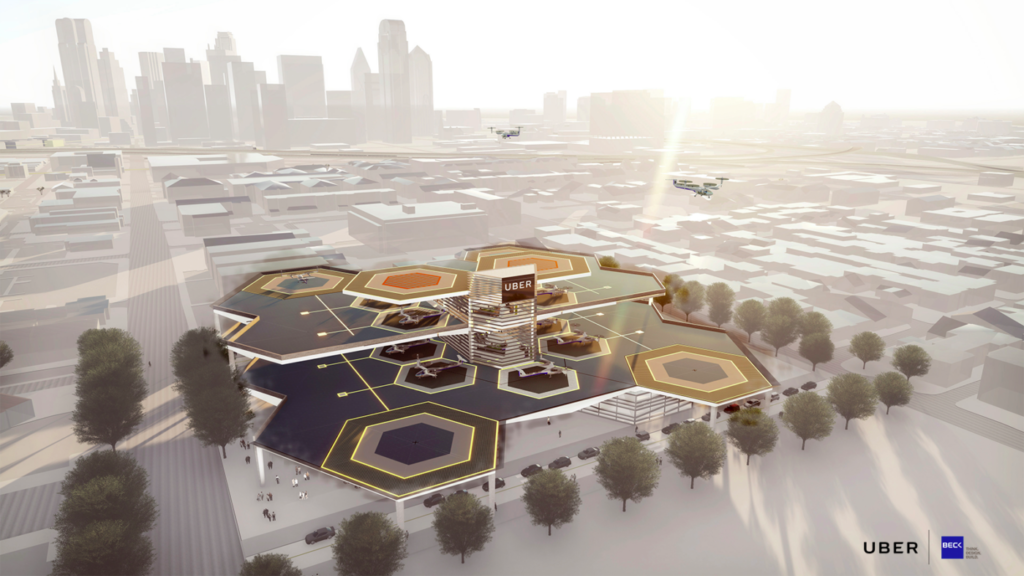
” ‘The Hive’ Skyport draws its inspiration from significant precedents in the design of transportation hubs, and from the beauty and practicality of the hexagonal form created by honeybees,” said Michael Kaiser, principal at The Beck Group. “Key features from historic train sheds and modern airports ground the design solution. Its shape is organic, practical and serves as a metaphor for activity. Skyport will be scalable, a key factor, as this type of transportation grows in popularity among Uber’s ever-mobile clientele.”
BOKA Powell — “Skyport Prototype”
BOKA Powell’s Skyport takes inspiration from the dynamics of flight and can accommodate 1,000 takeoffs and landings. The structure is flexible and allows for a reversal of the operation to accommodate wind change and can support an average takeoff of less than three minutes.
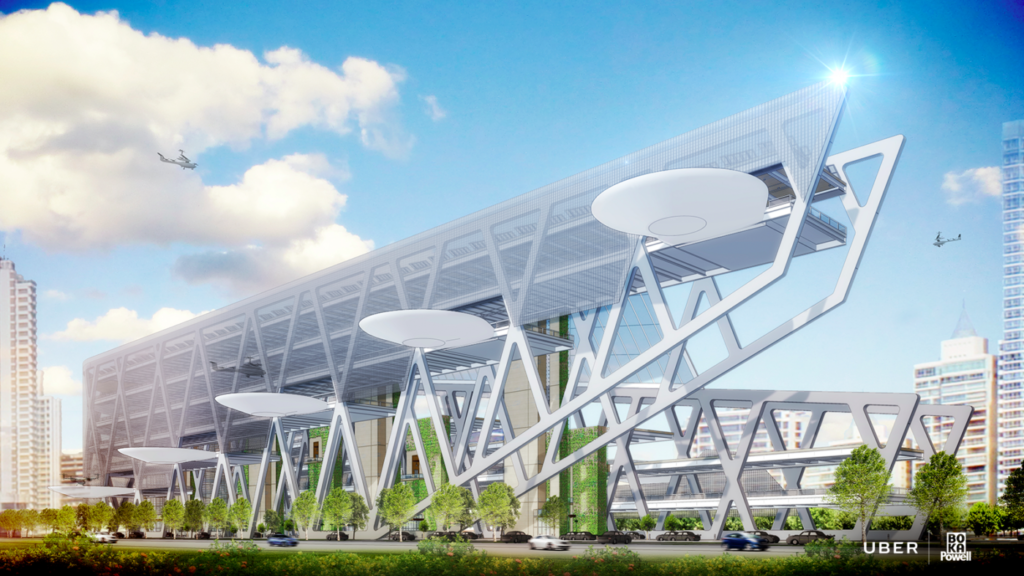
“A building typology so epic in scale and yet so clearly comprehended and practical in its use, this Skyport concept soars into the sky with dramatic aspiration for the future of flight and transit,” said Andrew Bennett, principal at BOKA Powell. “The real key to this solution is the mechanical precision and syncopated rhythm of handling both the aircraft and the customers. By solving these complex processes, the spirit and wonder of future aviation dreams are possible.”
About Uber Elevate
Uber launched its Elevate program in October 2016 with the publication of the first White Paper on Urban Air Mobility . Since then it has entered into partnerships with experienced aircraft manufacturers who are developing electric VTOL vehicles including: Embraer, Bell, Aurora Flight Sciences (now a subsidiary of Boeing), Pipistrel Aircraft and Karem. Uber’s design model specifies that this fully electric vehicle have a cruising speed between 150-200 mph, a cruising altitude of 1000-200 feet and be able to do trips of up to 60 miles on a single charge.
Last year, Uber announced its intention to launch flight demonstrations of uberAIR in Dallas-Fort Worth/Frisco Texas and Los Angeles in 2020 and commercially available trips by 2023. To help create skyports for the uberAIR network, Uber has also entered into real estate partnerships with Hillwood Properties and Sandstone Properties. Last fall, Uber released the first video of the uberAIR experience.
At the 2018 Elevate Summit, Uber announced an exclusive Space Act with NASA to focus on traffic management technologies and the impacts of urban air mobility (UAM). The company is also collaborating with E-One Moli to produce lithium ion battery packs for vehicles and has signed a Joint Work Statement with the U.S. Army to develop on rotor propellor technology. last fall.


